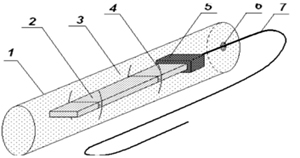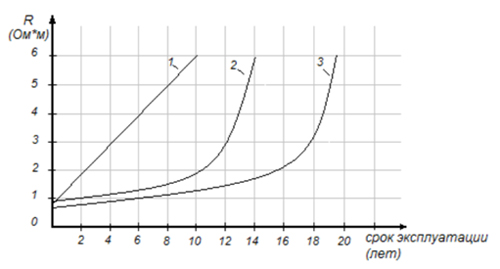«AZK» - COMPLETE ANODE GROUNDING ROD
Design
Anode grounding rod electrodes type AZK are supplied as complete units consisting of a cylindrical case of galvanized sheet steel, a central electrode and highly conductive carbon fill. The products are made of various kinds according to the technical conditions. The areas of use: oil, gas industry, and also the process of laying out and repairing of the water pipes and heating systems.
 1 - anode case;
1 - anode case;
2 - axial corrosion resistant electrode;
3 - carbon fill;
4 - centering holders;
5 - - water-tight connector;
6 - cable inlet;
7 - cable.
Two types of materials are used as central electrodes: ferrosilid (alloy ChS-15) and graphite-plast. Axial graphite-plast electrodes for AZK, together with corrosion-resistant highly conductive anode fill AZB ensure very low (not over 0.05 – 0.1 kg/A year) rate of electrochemical dissolution at maximum current loads.
Technical characteristics
| Parameters | Values | |
| Anode outside diameter, mm/td> | 100,150, 200 | |
| Length, mm | 500,1000, 1500 | |
| Use | Subsurface | |
| Current efficiency, A | 1 - 6 | |
| Service life, years | 10 - 40 |
Depending on the material of the central electrode, anode ground rods are divided into the following:
- Anode type: AZK, AZKF
- Axial electrode type: graphiteplast, ferrosilide electrode
The rate of dissolution of the anode grounding rod is the rate of dissolution of the carbon fill, which is lower than 0.6 kg/(Ayear) at maximum humidity and current load values. The main constituent of the fill is a special grade of high quality graphite with grain size of 5 to 35 mm and some smaller fraction. The number of grounding rods within the system and the distance between them are chosen as specified by the design of the cathodic protection system. Both vertical and horizontal positions of the rods are permissible; rods are installed in a manner common for other types of systems. Anode grounding rods AZK are intended for service under any climatic and soil conditions, within any type of cathodic protection systems. A standard set of grounding rods normally consists of 24 units; however, they can be delivered in any quantity on the customer’s request. AZK rods are not complete with connecting cables, but such cables can be delivered on request.
Comparison of AZK with other types of the anode grounding rods.
AZK grounding rods are an improved version of EGT graphiteplast tubes; their comparison is given below:
- the main advantage of AZK over EGT is in that with equal cost AZK of any version and weight has larger mass and hence greater operation potential;
-- AZK 1 of any version (length) of equal cost ensures lower spread and twice the operation potential vs. any version of graphiteplast tubes EGT;
-- AZK have no union nipples and nipple connections which are known to cause frequent ruptures of EGT tubes. AZK rods have reliable factory-made connectors with several levels of protection;
- AZK are easier to transport and simpler to install;
- versions AZK (G) are intended for use as great depth anode grounding rods. EGT cause great problems here as they are hard to install, labor-intensive, unreliable at connecting points and nipples. Moreover, vertical strings of them are hard to install and fix.
- with equal cost, AZKs 1 of any version (length)ensure 1.2 to 1.6 lower resistance compared to ZFS -1 along with 3 to 5 times greater service potential;
- AZK surfaces do not form non-conducting oxide films on them, as, e.g., ZFS do. Such oxide films cause quick failure of any iron-silicon anodes;
- AZK anodes can be used both with and without graphite fills, while ZFS-1 anodes cannot;
- AZK anodes are lighter than ZFS-1; they are easier to transport ,simpler to install;
- version AZK (G) function at great depths, while ZFS-1 cannot be used at large depths due to their great weight.
A very important advantage of anodes AZK over ZFS-1 and ZFS-B is a low rate of change in spread resistance with time. The diagram below shows changes in resistance to spreading vs service life in equal quantities of anodes of different types under similar soil conditions and under equal loads (20 A for a set of 24 anodes).
>
Comparison of AZK with other types of the anode grounding rods.

Resistance to spreading vs. service life in different types of anode grounding rods: 1 – ZFS -1 (EFS (B); 2 – AZK 1.2; 3 – AZK-1
As shown by the diagram above, AZK rods have, compared to ZFS-1 (EFS (B), a much longer period of a low initial resistance to spreading; this is, of course, a great advantage in service over ferrosilicon anode grounding rods . Note: line 1 in the diagram is optimistic, as actual characteristics of ZFS-1 rods are often much worse, especially under high moisture soil conditions.




